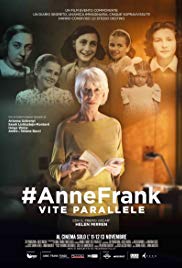
ANNE FRANK. PARALLEL STORIES
Italy, 2019, 92 minutes, Colour.
Helen Mirren, Martina Gatti.
Directed Sabine Fedeli, Anna Migotto.
Anne Frank would have turned 90 this year.
For the last 70 years, she has been a powerful focus of attention. There was the discovery of her diary and its publication, the support of her father, Otto Frank. There was a Broadway play. There were several film versions of her diary. There have been many documentaries. This commemorative documentary, while it focuses on Anne herself and the diary, it suggests in the title that there were many parallels of teenagers, Jewish teenagers in many European countries, who were eventually rounded up and killed. The point is made about how impoverished the world is because of the deaths of so much talent.
While this film has quite an amount of historic film footage, especially of the concentration camps, it also has a number of talking heads, survivors of the war, survivors of the Holocaust, their reminiscences and comment.
But the Italian filmmakers have a particular device for letting the audience hear quite a number of passages from the diary itself, giving the particular months and years of the entries in the diary, Anne in her early teens, moving towards 15, the letters she continually wrote to her imaginary penfriend, Kitty. Through these excerpts, the audience is able to build up a picture of Anne and the Frank family as well as the others who were hidden by locals in Amsterdam for two years before they were arrested.
For contemporary audiences, the filmmakers have asked Helen Mirren to be the communicator of these excerpts, building a replica of Anne Frank’s room in a studio in Mulan, having Helen Mirren enter, said at the desk, open an English version of the diary, and not only read with great expression, but also looking into the camera, communicating with the audience about the significance, the emotions, the impact of these excerpts.
At the same time, the filmmakers have another device of a girl, of Anne’s age, played by Martina Gatti, who has read the book, has been moved by it, has decided to go on a pilgrimage to the Anne Frank house, eventually arriving, absorbing the memories and atmosphere, making the empathetic link that she is the same age but has such a different life in the 21st-century.
There will be more films about Anne Frank – but this is a reminder that, had she lived, she would be 90 this year. However, in her short life and in her death, she has made a profound and continuing impact.
1. The impact of Anne Frank, her life, her diary, over the decades, in literature, theatre, film, documentary?
2. The title, the reminder that there were many other teenagers killed during the war, paralleling, though unknown, the well-known life of Anne Frank?
3. 2019, the year of Anne Frank’s 90th birthday?
4. The device of having Helen Mirren go to the room, the austerity of the reconstructed room, light and darkness, the desk? Helen Mirren at the desk, reading the excerpts, giving the months and years, highlighting the events in her development, the changes from 13 to 15, and Helen Mirren with her expressions, emotions, looking to camera, challenging the audience?
5. The device of the young girl, reading the book, getting to know Anne Frank, deciding to make the pilgrimage, her travel, the arrival in the room, her contemplation?
6. The talking heads, the memories of the war, the dangers, the presence of the Nazis, concentration camps?
7. The perennial audience for the stories of Anne Frank, her diary, the fact of two years within the apartment, moods, ups and downs, the writing of the diary? And the fact that it was found and promoted?